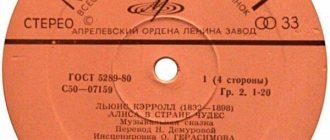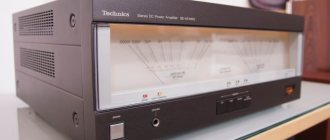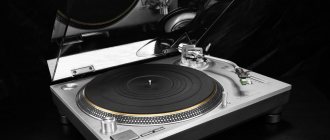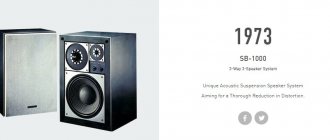In this article we will introduce you to the history of the legendary Technics SL1200 line of turntables. These players at one time determined the path along which DJing developed. They not only created this industry, they have dominated it for over thirty years. And they still successfully maintain their position as a leader in the market.
But what made these turntables so special and why are they still so highly regarded after all these years? In this complete guide, we'll look at each of the Technics SL1200 and SL1210 models to see why they're still the best turntables for DJs.
Date of issue:
October 1972
The SL1200 player was released in October 1972 as an ideological successor to the older SP-10 model. The original SL1200 became popular among radio DJs due to its direct drive motor. Removing the belt drive system gave the turntable good torque. And this, in turn, made it possible to reach full rotation speed almost immediately.
The direct drive motor also proved to be very precise and maintained a constant playback speed, which greatly reduced record shake during playback. In case of incorrect calibration, the company added a rotation speed control knob to the player, which was immediately actively used by DJs for beatmatching tracks.
Date of issue:
September 1978
The most popular model of the SL1200 series, the MK2, was produced from 1978 to 2010. Despite its name, this turntable has become much more than just a continuation of the original 1200. The completely new, designed from the ground up, the SL1200Mk2 introduced the same design familiar to all DJs today, which all subsequent models have tried to improve.
The SL1200 MK2 featured excellent isolation, a precise and stable motor, and fantastic sound quality. At the time, Technics even used the slogan "Cool enough to handle the disco beat, and precise enough to hold it."
For the first time, a turntable design was able to adequately cope with the vibrations caused by loud music in clubs and bars. Thus, the SL1200 MK2 has become the industry standard for DJs around the world. This 30-year-old turntable remains iconic to this day.
The direct drive motor has been upgraded and equipped with a quartz stabilizer, greatly improving playback stability. The speed control knob from the original model was replaced with a pitch fader, which would become a standard feature on all future decks.
WHAT IS THE DIFFERENCE BETWEEN SL1200 AND SL1210
The Technics SL1200MK2 turntable was sold in Europe under the name SL1210MK2. This European model had a dark gray finish, while the SL1200 sold in the American and Japanese markets had a silver finish.
In addition to color, the SL1210 models also featured voltage switching and a slightly different internal wiring system. A switch under the platter allows the user to change the voltage between 110-120V and 220-240V.
Date of issue:
Summer 1979
Sold exclusively in Japan, the SL1200MK3/D has been given a new darker color. The model was equipped with gold RCA cables and a metal sticker on the back of the turntable.
Date of issue:
Summer 1996
The SL-1200 Limited Edition was released in 1996 to celebrate the 25th anniversary of the original Model 1200. Only 5,000 units were produced in a striking black and gold finish. Like the MK3D, it featured a crystal-stabilized button, but retained the zero notch on the pitch fader.
Date of issue:
Summer 1996
MK4, aimed at audiophiles rather than DJs, allowed the company to improve the performance of the tonearm and the sound characteristics of the player. These improvements are made possible by a titanium tonearm and oxygen-free copper wiring. Additionally, MK4 also featured a 78 rpm playback speed.
Availability only in Japan and high import costs in other markets made the MK4 a rarity.
Date of issue:
Summer 1997
The 1997 M3D introduced several major modifications to the SL1200. The notch at the fader zero position has been eliminated and replaced with a physical pitch reset button. This allowed for more precise control of BPM when beatmatching and solved the dead zone problem that could develop over time with some older faders.
The M3D also gets rid of the dust cover hinges on the back of the player. Finally, the strobe light was changed from red to a softer orange, and the power switch was recessed into the body to prevent accidental shutdown.
Date of issue:
November 2000
On the MK5 version of the SL1200 player, the anti-rolling function of the stylus has been revised, increasing the range from 0–3 grams (0–30 mN) to 0–6 grams (0–60 mN).
The company solved the problem of dust cover hinges, which often broke, by adding magnets to their design. In addition, the needle illuminator has been updated. It now uses a white LED rather than the older incandescent bulb.
Date of issue:
November 2000
The M5G was introduced to celebrate the 30th anniversary of the 1200 line. In addition to its speckled gloss black and silver paint job, it featured blue backlighting on both the stylus illuminator and fader position indicators, which were now fully digital and offered 8% and 16% turn ranges.
Small improvements have also been made to the tonearm. In particular, the changes affected the wiring, which was replaced with oxygen-free copper to improve sound characteristics.
Release date:
November 2004
Launched to celebrate the 3 million players Technics sold over the past 30 years, the GLD was based on M5G standards. SL1200GLD is one of the rarest models. Only 3,000 examples were produced worldwide, 500 of which were exclusive to the Japanese market.
The device was again finished in black with gold accents. And although visually it is very similar to the earlier SL1200LTD, the gold here still has a different shade, i.e. The parts of these two models are not interchangeable.
Release date:
February 2008
In 2008, Technics released the SL1200MK6. Very minor improvements were made to the MK6, which included improved tonearm mounting and oxygen-free copper wiring. The materials used to create the MK6 have improved vibration damping in the player's body. The accuracy of the pitch fader has also been improved.
Release date:
Summer 2008
The MK6K1 was the last limited edition model before the SL1200 line was discontinued in 2010. This player was the same MK6, only painted matte black. A total of 1,200 models were produced, and each one came with a booklet and a gold vinyl record.
Release date:
May 2016
After discontinuing the entire line of SL1200 turntables in 2010, Technics resumed production in 2016 thanks to an online petition and the start of a vinyl revival. However, the SL1200GAE was a far cry from the DJ turntables on which it was based. Aimed at the audiophile market, the GAE was limited to just 1,200 units, each retailing for $4,000. The release of this player took place in honor of the 50th anniversary of the Technics brand. Later that year, the SL1200G model was released without any batch restrictions. Both players are equipped with a magnesium tonearm and an updated motor.
Release date:
January 2017
Since the SL1200G was aimed at audiophiles and high-end users, Technics released the SL1200GR as a more affordable model. This player is based on technology from previous years, but slightly simplified to reduce costs.
Many DJs prefer older models, and the SL1200GR doesn't get much respect. This is due to lower torque and a body that has become 7 kg lighter, which is why it copes worse with vibrations.
Release date:
January 2019
In response to user calls for a turntable for DJing, the Technics SL1200Mk7 was released in early 2022. The model received a matte black finish. The LED lighting can be changed from red to blue using switches located under the platter. There you can also adjust the motor torque, start/stop speed, as well as various playback functions. The disk itself can now spin in the opposite direction. To top it all off, the power and RCA cables are removable.
Technics SL-2000 and Technics SL 1200 MK3
Since such a booze has begun, I’ll tell you about my “mistakes” regarding this turntable. Maybe they will be useful to someone...
Five years ago, I received two devices at the same time, one of which was very little used, the legendary Technix 1200 and the new Vertigo, if memory serves, 4600.
A close relative of mine had a full anniversary and we slowly found out what kind of gift she wanted for her anniversary. Her desire was a vinyl player, because more than 300 vinyl records remained from Soviet times, and in very good condition. And at home they had a very decent, albeit conotheatrical system, on which they often listened to music.. Well, as they say, they decided to plunge into the past...)))
To experiment with the devices, I had three pickups in stock, one vintage mm Elak 344, a modern mm Nagaoka 150 and a Goldring Elite MC type. The phono stage was E.AR 834 sign.
I knew very well how these heads could sound on a good turntable and tonearm, my task was to find out how these heads would play on these turntables, I was also interested in finding out how much more interesting the “native” turntable sounded than the modern Chinese clone...
Different heads were installed on the devices one by one, and each head was carefully adjusted before testing...
The result discouraged me; I expected better sound from the “Japanese” legend!
In fact, the Chinese Wertig played almost the same as its Japanese counterpart, at three times the cost.
What was disappointing about the devices?
1. High level of rumble and not ideal vibration decoupling of the device with relatively high rated values.
2. A noticeable background level of 50Hz when the device’s motor is turned on, although with Technix it was noticeably lower.
3. None of the pickups passed the test plate test.
4. The most offensive thing was that on any of the heads the sound was rough, somehow “shrinked”, the sound lacked plasticity and the devices smeared the dynamics, especially the sound with the MC cartridge... Its transparent, airy sound turned into a normal one “disco”, a very rough and pop sound, the transparency and airiness of the mid-high frequency delivery were lost from the sound, and the bass lost speed and resolution.
What can be attributed to the advantages of these turntables is the cordless, “unbreakable” reliability of operation, the devices kept the speed “dead”, there were no questions about this.
In the end, we chose Vertiga as a gift, because the device was new and cost three times less than its original price...
This is my personal experience, I didn’t want to “destroy” someone’s Hopes and legend with my post, this is just my personal opinion...
WHAT TO PAY ATTENTION WHEN BUYING TECHNICS SL1200
Tonearm bearings:
The tonearm assembly should move freely and show no signs of play. Check the lift mechanism, counterweight and bearings to ensure the tonearm is strong and moves correctly.
Pitch adjustment:
The motor and pitch fader must be properly calibrated to accurately control playback speed. Refer to the dots on the edge of the dial to check fader accuracy. When playing at the zero fader position, the large dot should remain motionless.
Screws:
Check the bottom of the player for missing screws. This is a classic sign of previous poor quality repairs.
RCA connectors:
turntables that were used for DJing were often connected and disconnected from many mixers.
Original model RCA cables wear out over time. Check the connection and signal stability, especially when purchasing for DVS use. Platter:
Spin the platter when the player is turned off. No vibrations should be felt in the body. Make sure the platter rotates freely in both directions without any squeaks or resistance.
Original article.
Equipment
Technics is adamant about not adding unnecessary bells and whistles to players, but the SL-1210 MK7 makes a few useful changes. The first of them is the Reverse Play function: hold down one of the speed selection buttons, click Start/stop - and the platter will start spinning in the opposite direction. Shifting at 78 rpm is done in the same way.
In addition, starting torque and braking speed can be adjusted, thanks in part to motor technology advanced in the development of Blu-ray drives. This setup is a little more complicated and requires removing the platter to access switches hidden inside the player. Most people are unlikely to do this, but for professionals it gives additional room for experimentation.
The customization capabilities of the SL-1200 are not limited to this. In the same hidden area you can find a switch to change the color of the strobe backlight LED - from blue to red or back. Improved needle illumination provides increased visibility of the needle tip compared to previous models.
The interconnect and power cables of this model are removable - to the delight of those owners who want to replace them with connectors of a higher class.
Interim verdict
The new SL-1200 MK7, as expected, delighted music lovers. This is a worthy representative of the illustrious line, and those who dreamed of touching the stellar legacy of Technics DJ turntables will be happy to learn about the release of a new model aimed at this audience and available at a more modest price. We understand them perfectly.
The iconic player will only benefit from the current functionality update, and we are confident that the performance and sound quality of the finished product will also be excellent.
Quality of work
As always, the first impressions of a new product in a crowded showroom are just the beginning of the acquaintance. Conditions are far from ideal, time is short, and there is no possibility of comparison with similar products. But, of course, we still took the opportunity to touch the new turntable with our own hands, and later hear it as part of the Technics reference system.
If you like the company's style as much as we and many others do, then you'll definitely appreciate the new model. It looks very impressive in a black finish. There will be a lot of fuss about the lack of a silver option, but no one will be disappointed with the present version.
If you put the MK7 next to the more expensive models, the SL-1200G and SL-1200GR, it becomes obvious that it has a simpler design and workmanship. But this is logical - it is much cheaper.
As for reliability compared to previous generations, in particular the MK6, it is difficult to say for sure, but the buttons and LED indicator look less solid. We will find out how the turntable will perform during operation when we receive a copy for testing. According to rumors, DJs from around the world were involved in the design and development, so it has every chance to appeal to this category of users.
The new model played great at the Technics corporate stand. Technics CTO Tetsuya Itani said the sound signature is "very similar" to the new SL-1500C, with the quality definitely increasing as you go up the price line. We listened to the SL-1200 MK7 and SL-1500G turntables back-to-back, and the latter definitely featured increased detail and greater scale; but outside the context of comparison, the 1200 pleases with its balanced and musical sound.











